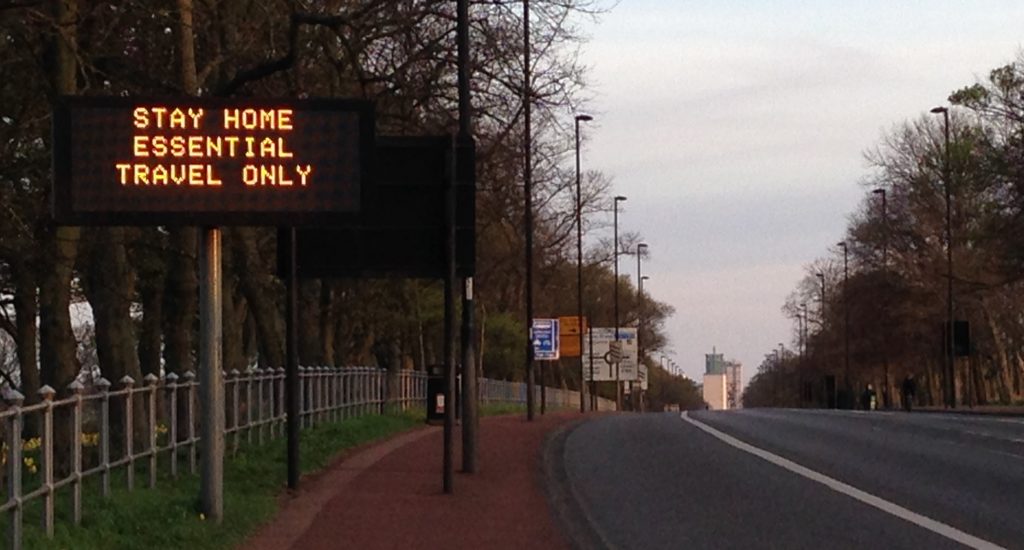
The Government and Council’s initial response to COVID-19 has been, quite rightly, to ensure people are safe and well, protect jobs and critical services, and to minimise the spread of the virus. Already by mid-April 2020 the virus has killed thousands of people in the UK alone, and left unchecked would kill many many more.
On March 23rd the Government announced lock-down, telling many businesses to close and no one to leave their house other than for a few essential reasons. Schools were also to close, other than for children of key workers, including those that work in the NHS, local and national government and key government services.
With schools closed and many of us now working from home, traffic levels in Newcastle have dropped substantially, as seen in the graph below from the Urban Observatory. Buses and Metro are running almost empty and instead many more people are out walking and cycling on local streets on their way to work, to shop for essentials or for exercise.
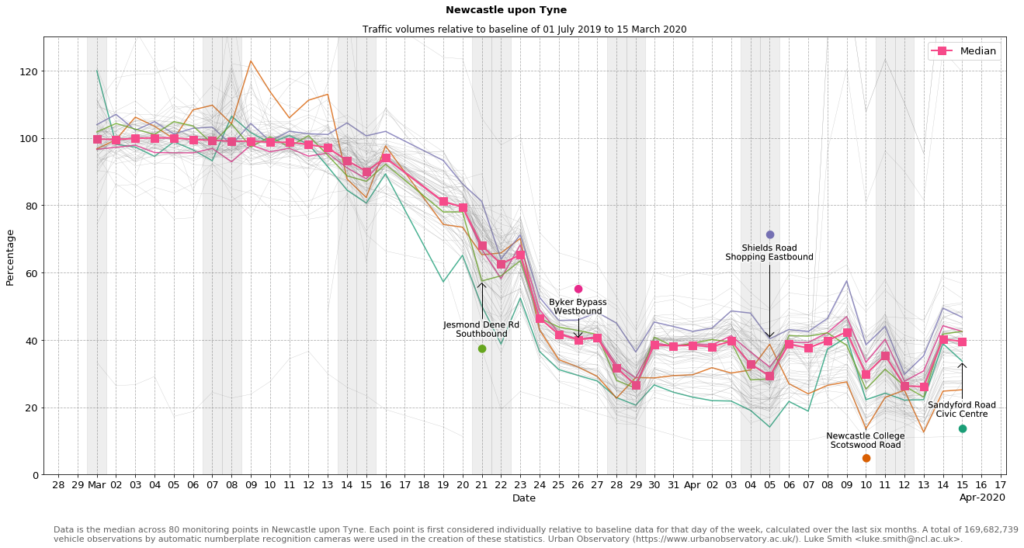
Air quality has started to improve (see the graph below for PM2.5 fine particulates on Gosforth High Street from the Urban Observatory). This would be beneficial for health under normal circumstances, but is especially so now as air pollution is correlated with a higher coronavirus death rate. According to a Harvard University study “an increase of only 1 μg/m3 in PM2.5 is associated with a 15% increase in the COVID-19 death rate.”

COVID-19 Transport Challenges
City Transport Planners no longer have to focus on managing high volumes of traffic through constrained urban junctions, or worry about vehicle delays and traffic jams.
The transport ‘behaviour change’ that Council Policy has long advocated for people to walk or cycle more to improve health has started to happen as traffic levels have declined, although speeding vehicles are still an issue.
People, especially doctors, nurses and other key workers still need to be able to travel though and, if walking or cycling, deserve to be protected from road danger. And the wider impact of how we travel on health needs to be considered to give us the best chance to beat the virus and minimise the burden on the NHS.
These all lead to some new questions for transport planners to answer, and in some cities they are already answering with physical changes being implemented.
- How can key workers, and others that cannot work from home, travel to work given the recommendation to avoid public transport? This is especially important for those without access to a car.
- How to ensure people can follow social distancing rules, in particular the 2m rule, and minimise transmission of the virus?
- How to enable exercise with all its physical and mental health benefits to offset the impact of isolation, and reduce pressure on parks and open spaces?
- How to minimise the number of traffic collisions to reduce non-COVID-19 pressure on the NHS? (“Lowering the Baseline“)
- How to get air pollution lower still, to minimise its impact on COVID-19 death rates and further reduce pressure on the NHS?
- How to plan for when restrictions are eased but social distancing still means many fewer (perhaps only 20% or 1 in 5 of pre-virus) people can use public transport?
https://twitter.com/citycyclists/status/1250672383490473984?s=20
How are Cities Responding?
Newcastle City Council has responded with a very generous offer of free parking for key workers, potentially costing the Council millions of pounds in foregone charges, as it is not clear that this is something the Government will refund.
This would make no sense under normal circumstances but, now traffic volumes are much smaller, parking charges are not so important for managing traffic levels or air pollution.
To continue to support key workers we are extending free #parking in all of our on and off street spaces in #Newcastle while #coronavirus #COVID19 lockdown arrangements are in place.
Read all about it: https://t.co/mAWzCqzles pic.twitter.com/k2FraTVS7y
— NewcastleCityCouncil (@NewcastleCC) April 14, 2020
Berlin, on the other hand is massively expanding safe traffic-free bicycle lanes to enable doctors, nurses and other key workers to travel to work, making roads safer, reducing hospital admissions due to traffic collisions and helping to minimise air pollution. As well as helping those without access to a car, it gives an additional cheap and healthy option for those that do.
This also creates a further option for exercise and, if retained as lockdown is eased, enables others without access to vehicle a way of travelling longer distances within the city without having to use public transport.
A lot of cities are talking about making wider bike infra during the #coronavirus crisis. In Berlin, they're going ballistic doing it. @PBroytman sent me this amazing gallery: https://t.co/jYR1nqOL7T AMAZING. pic.twitter.com/wAwhNat0CV
— Mikael Colville-Andersen (@colvilleandersn) April 10, 2020
In Sydney, Australia, pedestrian crossings have been changed to give an automatic green light rather than needing to press a button. Surfaces that are touched frequently, like pedestrian crossing buttons, lift buttons, petrol pumps or door handles are a known transmission risk, so this has the potential to reduce transmission of the virus. This is also why it is important to wash hands when returning home and avoid touching your face.
https://twitter.com/andrewconstance/status/1241872088249413632
In the West Midlands, NHS workers have been offered free travel on buses and trams. This is clearly a welcome gesture for those that have no choice but to use local buses or trams but of limited use given Government guidance to avoid public transport if at all possible.
I am pleased to announce that all NHS staff can now travel for free on buses and trams in the West Midlands. NHS workers are putting their lives on the line day after day to tackle Coronavirus, and we should be doing all we can to support them.https://t.co/bphffqxknZ pic.twitter.com/9cmyAODeBj
— Andy Street (@andy4wm) April 2, 2020
On the Isle of Man, the maximum speed limit including on rural roads has been set to 40mph. Reducing the speed limit means that crashes are less frequent and, when they do happen, less severe. This again helps reduce hospital admissions due to traffic collisions.
Reducing speed limits is one of the suggestions made by the Lower the Baseline campaign as outlined in this British Medical Journal blog. Baseline, in this case, meaning the number of hospital admissions for reasons not related to COVID-19 so that the NHS can maximise resources available to treat people who do have COVID-19.
To ALL motorists on the Isle of Man.
Please be advised that as of midnight tonight, there will be a maximum speed limit of 40mph on all roads over 40mph. You should observe 20mph and 30mph signs as normal.#40ToSaveLives pic.twitter.com/2L3jXvOdBR
— TweetbeatIOM #RespectIOM (@TweetbeatIOM) March 27, 2020
A number of American cities have closed streets to through traffic, substantially reducing traffic levels on those streets but retaining access for vehicles that need it. In our blog Lots of children want to cycle to school, but hardly any do. How do we make space for child cycling in Gosforth? we shared UK research that showed this was one of the types of roads that parents would be happy to use cycling with their children.
Boston, Minneapolis, Oakland and other cities have temporarily banned through traffic on streets, giving pedestrians and cyclists extra elbow room during the coronavirus pandemic-Cities Close Streets to Cars, Opening Space for Social Distancing – The NYT https://t.co/D8DQSPIHqB
— IFPedestrians (@IFPedestrians) April 12, 2020
In Hackney, East London, a similar approach is being taken showing that it is possible to implement access-only streets quickly in the UK.
#Hackney (#London) announces plans to "filter" streets, to protect people from rat running drivers & ease pressure on parks & open spaces during #COVID19 crisis – https://t.co/nZQc5kEHZy https://t.co/d8U3P4uNhp thanks @laura_laker
— IFPedestrians (@IFPedestrians) April 12, 2020
In Liverpool, the no-cycling restriction on the Queensway Tunnel is being relaxed so people who need to can use the route for essential journeys.
https://twitter.com/Merseytravel/status/1250077816345047042
In Barnes, in London, local businesses have taken the initiative to cone off part of the road for people to use on foot or when queuing for shops.
https://twitter.com/raphaelzy3/status/1248604675764436996
In Washington DC, cones and barriers have been used where there are narrow pavements, to allow people to pass without having to step into the road. Now there is much less vehicle traffic, it makes sense to reallocate space to where it is most needed.
https://twitter.com/CatrionaSwanson/status/1248876216758796289
Perhaps the two most impressive responses so far are from France and New Zealand.
In France, the government has confirmed that it is planning on cycling being the principal transport mode once restrictions are eased. Certainly if the vast majority of public transport users were to drive instead, as may well happen if cities do not intervene, then congestion, pollution, road danger and greenhouse gas emissions would all increase substantially. For the UK, that in addition to COVID-19 would place a substantial burden on the NHS.
https://twitter.com/citycyclists/status/1250401656870703104
In New Zealand, the government has confirmed a new ‘tactical urbanism’ fund. People have already changed how, when and why they travel as a result of COVID-19. This fund will support cities to implement changes that support these new patterns of movement.
Seizing an opportunity for rapid and radical change. Tactical urbanism in New Zealand to fund pop-up bike lanes, and widened sidewalks during lockdown https://t.co/4wxSvS7RcX
— Tom Rushby (@tom_rushby) April 14, 2020
These are all just examples of what cities are doing. We have included a longer list below and the American Pedestrian and Bicycle Information centre is also maintaining a list here. If you are on Twitter, you might want to follow @BrentToderian, @citycyclists and @MikeLydon, all of whom have shared multiple examples on their Twitter feeds.
What is perhaps most striking about these changes is how quick they have been implemented. Covid-19 is a genuine crisis, and in an emergency authorities need to react quickly expediting normal processes if required.
COVID-19 vs Air Pollution deaths
Many of the changes proposed above and in the longer list below will also support a reduction in air pollution, and as a result a reduction in people suffering and dying from conditions caused by air pollution. Reducing air pollution will also help reduce chronic respiratory and heart diseases that make it harder for someone to recover from COVID-19.
Right now, COVID-19 is the absolute priority and the graph below illustrate why. 40,000 deaths per year in the UK from air pollution equates to approximately 12 deaths per million per week vs 40 per week from COVID-19 and accelerating fast in week 7 in the USA.
Over time though, air pollution is still a substantial threat to health so Governments and Local Authorities need to ensure that in responding to COVID-19 they are not delaying further the urgent action that is required to address the threat from air pollution. It is likely that there will be further future COVID-19 outbreaks, after the one we are in now, and if air pollution can be cut that will help reduce death rates in those future outbreaks.
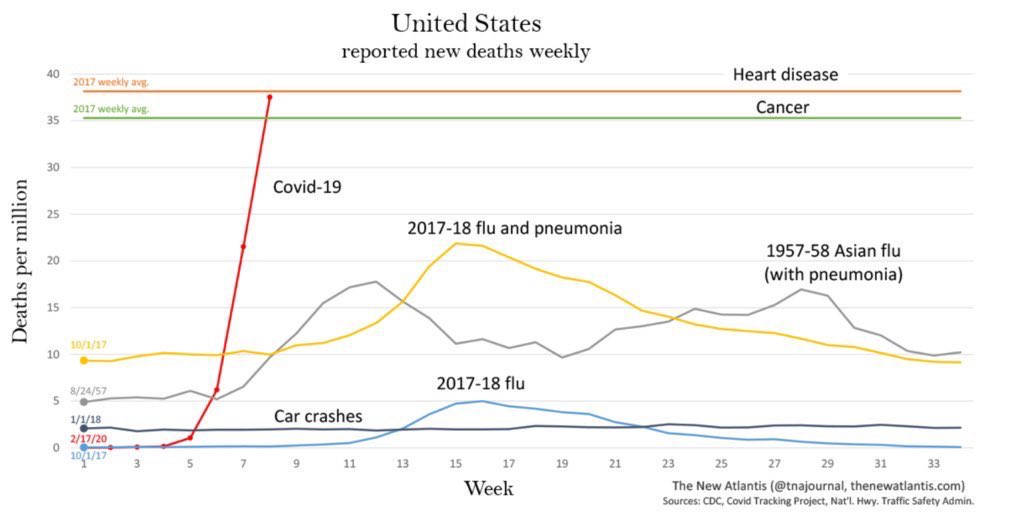
Source: https://twitter.com/VincentRK/status/1251140496870735872
WHO Technical Guidance: Moving around during the COVID-19 outbreak
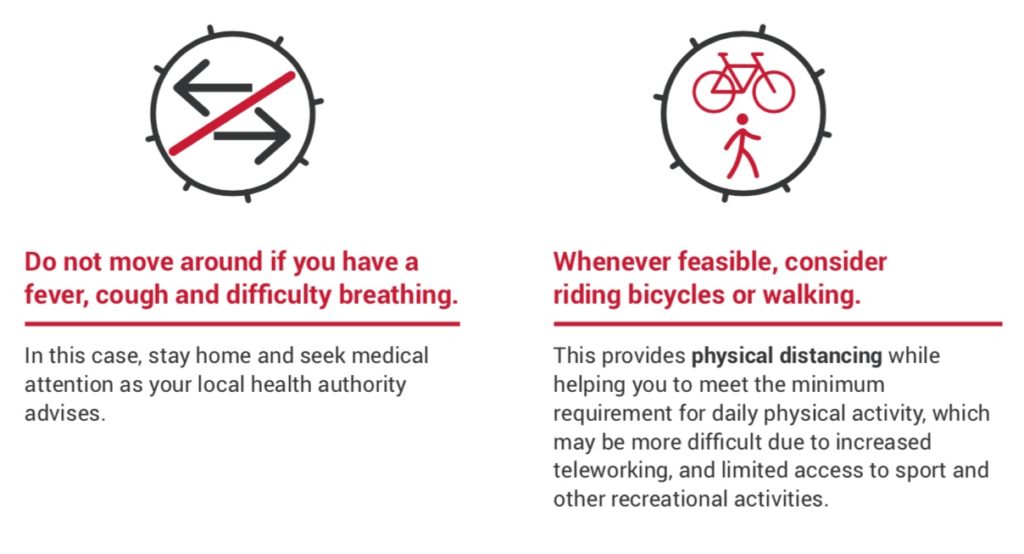
ACTIVE TRAVEL CHANGES
Sydney, Australia
Automated pedestrian crossings.
Source: https://twitter.com/andrewconstance/status/1241872088249413632
Queensland, Australia
Automated pedestrian crossings.
Source: https://twitter.com/TMRQld/status/1244746383262912519
Brussels, Belgium
Brussels adapts >100 traffic lights in favor of cyclists and pedestrians. Waiting times reduced by 20sec (average), some up to 40sec.
Source: https://twitter.com/dimitristrobbe/status/1246092862653153280
Brussels is putting massive plant pots in the streets to create extra space for walking and cycling
Source: https://twitter.com/citycyclists/status/1250157191778222080
Seattle, Washington, USA
Changing signal times to reduce wait times for people walking and cycling.
Source: https://twitter.com/seattledot/status/1248762875025465346
Bogotá, Columbia
22km of new in-street bikeways are being created “overnight,” by turning a lane for cars into two-way bike-lanes
Source: https://twitter.com/BrentToderian/status/1239581801279942659
Calgary, Canada
Testing weekend road closures on 6 major roads, disabled 50 pedestrian ‘beg buttons’
Source: https://twitter.com/BrentToderian/status/1244000505262563330
Berlin, Germany
Replacing car lanes with new cycle paths
Source: https://twitter.com/philipoltermann/status/1244189207867854848
Also: https://twitter.com/colvilleandersn/status/1248645263457214464
Bristol, UK
Replacing part of the road with a running lane (unofficial)
Source: https://twitter.com/DrLouisRice/status/1243913532544028679
New Zealand
Government fund for pop-up bike lanes and widened sidewalks
Source: https://twitter.com/tom_rushby/status/1250033398053289984
Denver, Colorado, USA
Some Denver streets will close to cars
Source: https://twitter.com/MikeLydon/status/1246500510116577281
Budapest, Hungary
Budapest to install bike lanes will help traffic during the pandemic, and encourage greater use of cycling as people start to return to work.
Source: https://twitter.com/PatrickDuce/status/1247807344517369856
Oakland, California, USA
74 miles of street closures
Source: https://twitter.com/ashk4n/status/1248442190017122304
Also (video): https://twitter.com/carltonreid/status/1249987195324239872
Brookline, Massachusetts, USA
Sidewalk widening
Source: https://twitter.com/MassDCR/status/1248670215300358152
Also: https://twitter.com/BlineTransport/status/1250512090617516032
Washington DC, USA
Wider sidewalks
Source: https://twitter.com/CatrionaSwanson/status/1248876216758796289
France
Bicycle to be the principal transport mode to enable social distancing
Source: https://twitter.com/citycyclists/status/1250401656870703104
Berkeley, California, USA
Repurposing streets for essential traffic only (unofficial)
Source: https://twitter.com/WalkBikeBerk/status/1250278699645067264
Liverpool, UK
To assist key workers making essential journeys cross river, the Queensway (Birkenhead) Tunnel will temporarily be open to cyclists
Source: https://twitter.com/Merseytravel/status/1250077816345047042
London, UK
TfL considers measures during lockdown to help physical distancing
Source: https://twitter.com/EmmaGibsonLTW/status/1250343251552305152
Hackney, London, UK
Filtered streets to protect people from rat running drivers and ease pressure on parks and open spaces.
Source: https://twitter.com/london_cycling/status/1250065125933043717
Burlington, Vermont, USA
17.5 miles of slow streets.
Source: https://twitter.com/MikeLydon/status/1250054691347738627
Manchester, UK
Filtered neighbourhood streets
Source: https://twitter.com/NQForum/status/1249315086684106752
Brighton and Hove, UK
Roads reclaimed by pedestrians and pedal power
Source: https://twitter.com/citycyclists/status/1249607388883279872
Montreal, Canada
A parking lane will be closed along a 2.7km stretch of Mont-Royal Avenue, to make it easier for people to walk to shopping.
Source: https://twitter.com/BrentToderian/status/1248076792683888640
North Vancouver, Canada
Road closed other than to cycles
Source: https://twitter.com/jordanback/status/1248670445743661057
Edmonton, Brampton, Montreal, Kitchener, Vancouver & Winnipeg, Canada
Bicycle / active transportation routes.
Source (see thread): https://twitter.com/g_meslin/status/1248434325692923904
Also (Vancouver): https://twitter.com/cfulgham/status/1248326654537195525
Barnes, UK
Pavement widening next to shops
Source: https://twitter.com/raphaelzy3/status/1248604675764436996
Austin, Texas, USA
Removing car lanes to create cycle lanes
Source: https://twitter.com/citycyclists/status/1248908428963131392
San Francisco
Rapid transformation to prioritise transit and cycling
Source: https://twitter.com/KCGrock/status/1248019256282738689
DesMoines, Iowa, USA
Opening streets around a park for social distancing.
Source: https://twitter.com/LenaGReynolds/status/1250127581535404037
Milan, Italy
Turning 35km of streets over to cyclists and pedestrians
Source: https://www.theguardian.com/world/2020/apr/21/milan-seeks-to-prevent-post-crisis-return-of-traffic-pollution
PRIVATE VEHICLE / PUBLIC TRANSPORT CHANGES
London, UK
Road user charging suspended
Source: https://twitter.com/TfL/status/1241085664050937860
Isle of Man, UK
Reduced speed limit to 40mph max.
Source: https://twitter.com/TweetbeatIOM/status/1243579094207520769
Vienna, Austria
Reduced speed limits, people asked to walk in the streets
Source: https://twitter.com/citycyclists/status/1248708352064045056
Newcastle upon Tyne, UK
Free parking
Source: https://twitter.com/NewcastleCC/status/1250121831517958147
West Midlands, UK
Free bus and tram travel for NHS workers
Source: https://twitter.com/andy4wm/status/1245752164208836610
SUMMARY ARTICLES
Can we improve the NHS’s ability to tackle covid-19 through emergency public health interventions?
Source: https://blogs.bmj.com/bmj/2020/03/24/can-we-improve-the-nhss-ability-to-tackle-covid-19-through-emergency-public-health-interventions/
TOP 10 WAYS cities can create NEW space on streets for people walking & biking close to home while #PhysicalDistancing during the #COVIDー19 pandemic, video by Brent Toderian
Source: https://twitter.com/BrentToderian/status/1248289951868801024
Op-Ed: Let’s Build a Network of ‘Quiet Streets’, John Massengale, StreetsBlogNYC
Source: https://nyc.streetsblog.org/2020/03/30/op-ed-lets-build-a-network-of-quiet-streets/
To help get essential workers around, cities are revising traffic patterns, suspending public transit fares, and making more room for bikes and pedestrians. CityLab article
Source: https://www.citylab.com/transportation/2020/04/coronavirus-city-street-public-transit-bike-lanes-covid-19/609190/
World cities turn their streets over to walkers and cyclists
Source: https://twitter.com/dbornat/status/1248890401634779136
Coronavirus: Cycling numbers in Scotland jump during lockdown
Source: https://www.bbc.co.uk/news/uk-scotland-52269964
Massive shift from public transport to private car in China as a result of Covid-19
Source: https://twitter.com/giulio_mattioli/status/1248969813776633858
Financial Times: “The growth in demand for bikes reflects in part a reluctance among healthcare staff to commute on public transport services”
Source: https://twitter.com/citycyclists/status/1248899401248133120
Opinion: the magic of empty streets – New York Times
Source: https://www.nytimes.com/2020/04/08/opinion/coronavirus-tips-new-york-san-francisco.html
Transport in the time of the Coronavirus crisis: what we need to do NOW, Road danger reduction forum
Source: https://rdrf.org.uk/2020/04/11/transport-in-the-time-of-the-coronavirus-crisis-what-we-need-to-do-now/
How Councils and Transport professionals can work on active travel to address the impact of Covid 19, Mark Strong.
Source: https://twitter.com/ibikebrighton/status/1249830229369069573
Tracker for how cities respond – Mike Lydon & ITDP US
Source: https://twitter.com/ITDPUS/status/1249788874118791168
US National Association of City Transportation Officials (NACTO) COVID-19: Transportation Response Center

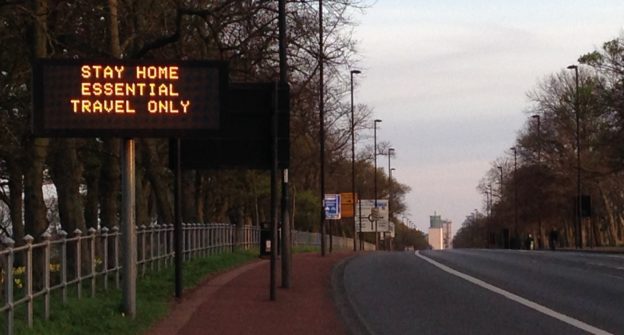
Very interesting information.Thank you.In Gosforth the air is a lot cleaner,not much noise from traffic,starting to observe more wildlife at close quarter herds of 8 or 9 deer spotted near Nature Reserve.Sparrowhalk seen on garden wall in Archibald street.Duck with a lot of ducklings seen seen near Salters bridge.Sadly ,although Hollywood avenue does not get much traffic at the moment,majority of vehicles using it are speeding.Sadly a white domestic was hit and killed by a vehicle on Hollywood a few days ago.
Article by the Guardian.
Europe doubles down on cycling in post-Covid recovery plans
Success of schemes during pandemic has led many cities to plan vastly expanded bike networks
https://www.theguardian.com/lifeandstyle/2021/mar/12/europe-cycling-post-covid-recovery-plans
New study: Provisional COVID-19 infrastructure induces large, rapid increases in cycling https://www.pnas.org/content/118/15/e2024399118
“Active travel makes people healthier and creates a wide range of additional social and environmental benefits. The provision of dedicated infrastructure is considered a crucial policy to increase cycling. However, evaluating the impact of this type of intervention is difficult because infrastructure changes are typically slow. The rollout of so-called pop-up bike lanes during the COVID-19 pandemic is a unique empirical context to estimate the pull effect of new cycling infrastructure. We show that the policy has worked. We find large increases in cycling. “